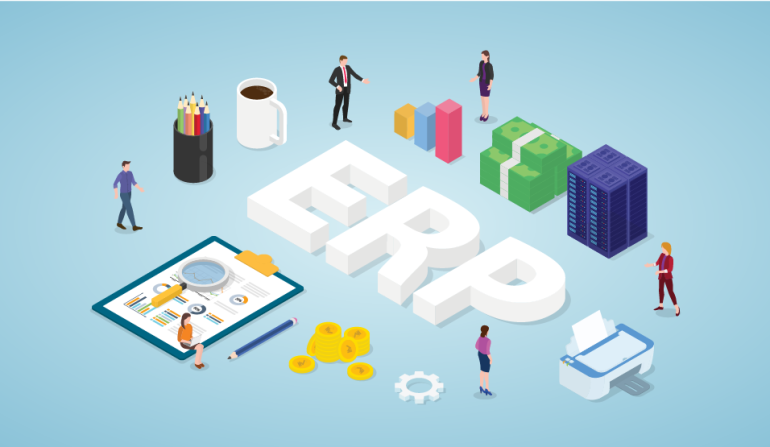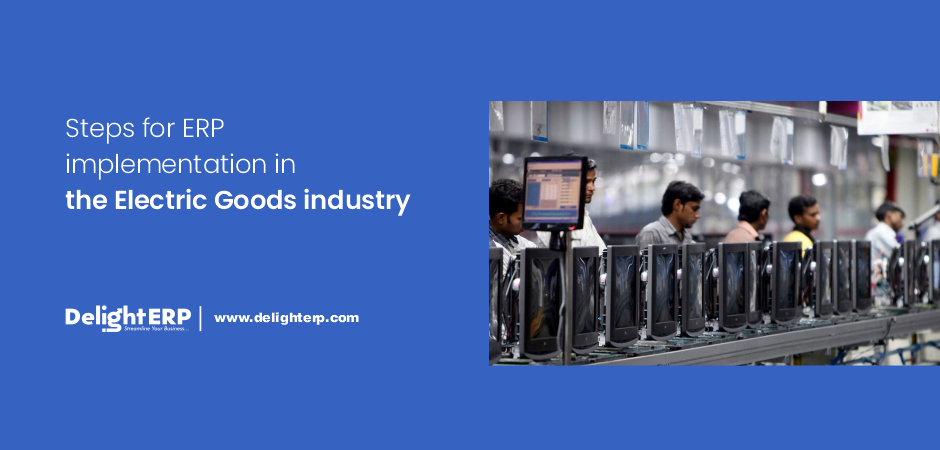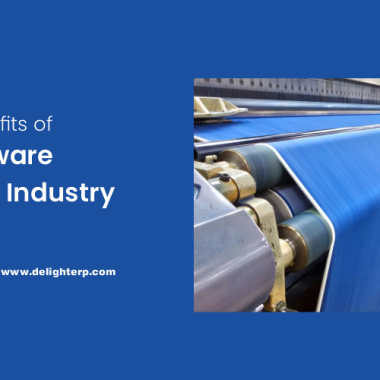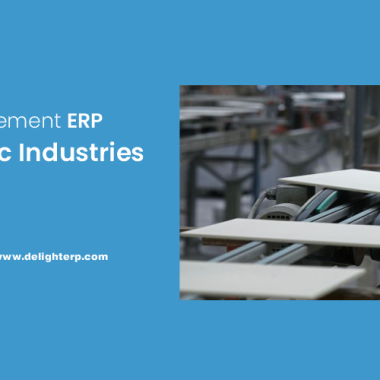Introduction
The electric goods industry is constantly evolving with advancements in technology and customer demands. It’s essential for businesses in this industry to stay competitive by adopting the latest tools and technologies. One such technology that has proven to be a game-changer for many companies is ERP (Enterprise Resource Planning) software. ERP software helps businesses to integrate all their key operations and functions, from finance and accounting to supply chain management and customer relationship management. However, implementing an ERP system is not an easy task, and it requires careful planning and execution.
The use of an Enterprise Resource Planning (ERP) system is becoming increasingly necessary for electric goods traders.

Below are the steps and why it is necessary:
Steps for ERP implementation in the electrical goods industry:
1. Product Design and Development:
In this production process, the company designs and develops new electric goods. The ERP system can help manage the product development process, including design documentation, engineering changes, and approval workflows.
The following steps are involved in implementing an ERP system for product design and development:
- Define the product development process and identify key stakeholders
- Choose an ERP system that supports product development workflows and document management
- Customize the ERP system to match the company’s product development process
- Train employees on how to use the ERP system for product development
- Deploy the ERP system and monitor its performance.
2. Procurement:
The procurement process involves sourcing and purchasing raw materials and components needed for the production process. The ERP system can help manage the procurement process by providing real-time visibility into inventory levels, automating purchase orders, and managing supplier relationships.
The following steps are involved in implementing an ERP system for procurement:
- Define the procurement process and identify key stakeholders
- Choose an ERP system that supports procurement workflows, inventory management, and supplier management
- Customize the ERP system to match the company’s procurement process
- Train employees on how to use the ERP system for procurement
- Deploy the ERP system and monitor its performance.
3. Production Planning:
The production planning process involves scheduling production runs, managing inventory levels, and ensuring that production runs efficiently. The ERP system can help manage the production planning process by providing real-time visibility into inventory levels, automating production scheduling, and optimizing production workflows.
The following steps are involved in implementing an ERP system for production planning:
- Define the production planning process and identify key stakeholders
- Choose an ERP system that supports production planning workflows, inventory management, and production scheduling
- Customize the ERP system to match the company’s production planning process
- Train employees on how to use the ERP system for production planning
- Deploy the ERP system and monitor its performance.
4. Bill of Material (BOM) Management:
The Bill of Material (BOM) is a comprehensive list of the components used in the schematic, along with the detail of the manufacturer’s parts, their number, and quantity. ERP systems provide a centralized source used to manufacture a product and serve as a basis for product design and manufacturing business activities such as R&D, Production, Logistics, Procurement, Inventory, Pricing, and Sales. The ERP system enables businesses to evaluate and validate levels of BOM (Bill of Material), accuracy, completeness, and consistency.
5. Quality Control:
The quality control process involves ensuring that products meet the company’s quality standards. The ERP system can help manage the quality control process by providing real-time visibility into production processes, automating quality inspections, and managing quality control workflows.
The following steps are involved in implementing an ERP system for quality control:
- Define the quality control process and identify key stakeholders
- Choose an ERP system that supports quality control workflows, inspection management, and quality metrics tracking
- Customize the ERP system to match the company’s quality control process
- Train employees on how to use the ERP system for quality control
- Deploy the ERP system and monitor its performance.
6. Inventory Management:
The inventory management process involves tracking inventory levels, managing stock levels, and ensuring that the company has the right inventory levels to meet customer demand. The ERP system can help manage the inventory management process by providing real-time visibility into inventory levels, automating inventory replenishment, and managing stock levels.
The following steps are involved in implementing an ERP system for inventory management:
- Define the inventory management process and identify key stakeholders
- Choose an ERP system that supports inventory management workflows, inventory tracking, and demand forecasting
- Customize the ERP system to match the company’s inventory management process
- Train employees on how to use the ERP system for inventory management
- Deploy the ERP system and monitor its performance.
7. Manufacturing Using Dynamic Routing:
Manufacturing with dynamic routing allows businesses to command their input time and supervise their routing & resources. With the aid of an ERP system, businesses can accurately define their work shifts, including their holidays and workers’ leaves, giving them comprehensive visibility of their available input time. Once the input time is visible, the same is utilized in planning the manufacturing orders. ERP systems allow custom logic to create MO (Manufacturing Orders) manually or automatically. Bill of Materials (BOM) and CPL (Component Placement List) can be imported into the system and linked to MO automatically.
8. Sales and Distribution:
The sales and distribution process involves managing customer orders, order processing, and shipment. The ERP system can help manage the sales and distribution process by providing real-time visibility into inventory levels, automating order processing, and managing customer relationships. The following steps are involved in implementing an ERP system for sales and distribution:
Define the sales and distribution process and identify key stakeholders Choose an ERP system that supports sales and distribution workflows, order processing, and customer management Customize the ERP system to match the company’s sales and distribution process Train employees on how to use the ERP system for sales and distribution Deploy the ERP system and monitor its performance.
9. Streamlined Supply Chain Management:
With an ERP system, you can manage your entire supply chain, including suppliers, manufacturers, distributors, and retailers, from a single platform. This helps to improve communication, reduce lead times, and optimize inventory levels, resulting in lower costs and improved customer service.
10. Financial Management:
The financial management process involves managing financial transactions, budgeting, and financial reporting. The ERP system can help manage the financial management process by providing real-time visibility into financial data, automating financial transactions, and managing budgeting and forecasting. The following steps are involved in implementing an ERP system for financial management:
Define the financial management process and identify key stakeholders Choose an ERP system that supports financial management workflows, financial reporting, and budgeting and forecasting Customize the ERP system to match the company’s financial management process Train employees on how to use the ERP system for financial management Deploy the ERP system and monitor its performance.
11. Human Resource Management:
The human resource management process involves managing employee information, payroll processing, and employee benefits. The ERP system can help manage the human resource management process by providing real-time visibility into employee data, automating payroll processing, and managing employee benefits. The following steps are involved in implementing an ERP system for human resource management:
Define the human resource management process and identify key stakeholders Choose an ERP system that supports human resource management workflows, payroll processing, and employee benefits management Customize the ERP system to match the company’s human resource management process Train employees on how to use the ERP system for human resource management Deploy the ERP system and monitor its performance.
12. Enhanced Customer Relationship Management:
An ERP system can help you to manage your customer relationships better by providing real-time access to customer data, including purchase history, preferences, and feedback. This information can be used to tailor marketing and sales efforts to individual customers and improve customer satisfaction.
13. Increased Operational Efficiency:
An ERP system automates many manual tasks, such as data entry, inventory tracking, and financial reporting, reducing errors and freeing up staff to focus on more strategic tasks. This results in increased productivity and lower operational costs.
Scalability: An ERP system can grow with your business and adapt to changing market conditions and customer demands. It provides a flexible platform that can be customized to meet your unique business needs and integrate with other systems and applications.
Benefits of ERP:
Here are some excellent benefits of ERP that you must take note of:
1. Higher Productivity
ERP helps you to control each day’s schedules in a well-timed and systematic manner. It promotes centralized database assistance and facilitates control optimize each aid. ERP fosters subtle strategic making plans, set off and diligent decision-making, more advantageous speed, higher synchronization, and dealing with massive chunks of records.
Here are some approaches wherein ERP improves enterprise productivity.
- It streamlines economic operations and manages the income technique and different departmental processes.
- An Enterprise Resource Planning answer gives accurate, real-time facts for higher decision-making.
- A current ERP device guarantees to set off a conversation among personnel for higher collaboration and more productivity.
- It integrates departmental records and makes them effortlessly available to personnel.
2. Cost Effective & Time Saving
Reduced enterprise charges assist to enhance income and growth, which is the purpose of each enterprise owner. When duties are automatic and facts are consolidated in a single platform, ERP gets rid of the want for revising, looking for, and storing paper files. ERP reduces errors, saves time, and guarantees no extra charges crop up.
Here are the perks of the use of ERP:
- You don`t need to spend money on more than one software program programs.
- More work can be completed in much less time.
- Operational costs are reduced even by enhancing worker performance.
- IT can focus more on the critical areas of business.
ERP decreases costs and improves profitability in an organization. It encourages lean production, which facilitates to:
- Lower economic expenditures
- Reduce deliver costs
- Modernize your advertising and marketing efforts
- Boost efficient time strategies
- Improve your personnel` skills
- Retain your customers
- Improves product quality
3. Forecasting
Before we discover how ERP facilitates you with forecasting, let`s see the 4 motives why forecasting is important to your enterprise:
- To apprehend the elements which are chargeable for more advantageous income (e.g., season, trends, etc.).
- To decide optimum stock levels.
- To enhance income and inspire higher client relationships.
- To ensure enough stock is on hand to meet customer demand
- In manufacturing organizations, planners normally face a crisis-like state of affairs whilst their organization studies a sudden call for for a specific product. It is the equal situation whilst, in a slack season, the warehouse overloads with unsold extra stock.
Thus, to keep away from such adverse situations, agencies opt to use an organization aid making plans software program device that doesn’t disturb the logistics and the whole delivery chain technique.
ERP brings sanity to production, income, procurement, and stock plans. It facilitates you to generate forecasts and income reviews primarily based totally on ancient transactions. This avoids issues by minimizing out-of-inventory or extra-stock situations.
Plus, its clever document abilities make sure that the organization responds effortlessly to complicated records. Users also can run their reviews without counting on IT personnel. User-pleasant ERP modules make the lifestyles of planners less complicated and much less tedious.
With ERP, there may be no greater manually fetching records and spending hours developing reviews. Users can are expecting destiny calls for and layout fabric requirement plans appropriately. Powerful enterprise intelligence gear makes reporting less complicated in order that control can get a view of the whole organization.
4. Easy Collaboration
Are your records nevertheless divided into exclusive databases, and is it hard to get entry to? ERP holds the important thing to integrating disparate organizational records and making them effortlessly available for customers.
- With an ERP device, there isn`t the want to spend money on more than one software program which includes CRM, HRM, MRP, and accounting gear. You get all of this capability in a single device with centralized records this is effortlessly available.
- ERP gets rid of redundancy and facilitates you to keep the consistency, accuracy, and pleasant of the organizational records.
- Consolidated records facilitate worker performance and productivity.
- It promotes inter-departmental collaborative efforts.
5. Higher Data Security
Data facilitates an organization`s growth, so it`s critical to have a stable infrastructure. ERP structures have exquisite records security. And managers and supervisors can beautify records regulations on their initiatives and requirement. Whatever records you insert withinside the ERP device are secured and coded.
Older ERP structures had been susceptible to cyber thefts due to the fact they required guide updates to each factor of the software program. With new technologies, the ERP company releases auto-updates well-timed, putting off the threat of records theft.
6. Increased Employee Efficiency
ERP customers can get entry to enterprise records from their cellular phone, tablet, laptop, or laptop everywhere and at any time. Mobile-pleasant ERP allows personnel smooth get entry to files to edit and approve at the go. Mobile-pleasant packages for the store ground, warehouse control, etc., assist ground managers leverage facts.
7. A One-Stop-Shop
To assist corporations to generate new enterprises and keep client and provider relationships. All applicable provider, client, and prospect files, communications, workplace locations, and organization contacts may be correctly saved in a single place. Activities and duties which include calls or emails may be scheduled towards a contact, so it seems at the user`s dashboard.
8. Projects
In ERP, you may consider task features as a glue that binds collectively numerous records and enterprise processes, consisting of engineering, income, making plans and scheduling, delivery chain, warehousing, production, service, and finance and accounting.
Many engineer-to-order high-tech manufacturers, specifically low-volume / high-blend manufacturers, follow giant sources to control client-particular orders. For those styles of businesses, it turns into important that they control sources and profitability on a task-through-task basis. These businesses want task capability to plan, schedule, track, and account for lots of related activities. In addition to comparing actuals towards budgets and estimates on schedule, cost, and earnings dimensions, they could avail themselves of task invoicing strategies and task sales popularity policies.
Conclusion
Thus, implementing an ERP system in the electric goods industry involves several production processes, each of which requires a specific set of steps. By following the steps outlined above for each production process, companies can optimize their production processes, streamline workflows, and reduce costs. An effective ERP system can help businesses enhance their efficiency, productivity, and profitability in today’s highly competitive business environment.
Delight ERP is one of the leading Custom ERP software development company in Rajkot, Gujarat (India). Our best ERP system is a cost-effective solution to help you to establish a fully integrated & smart business.
Contact us for more information.





